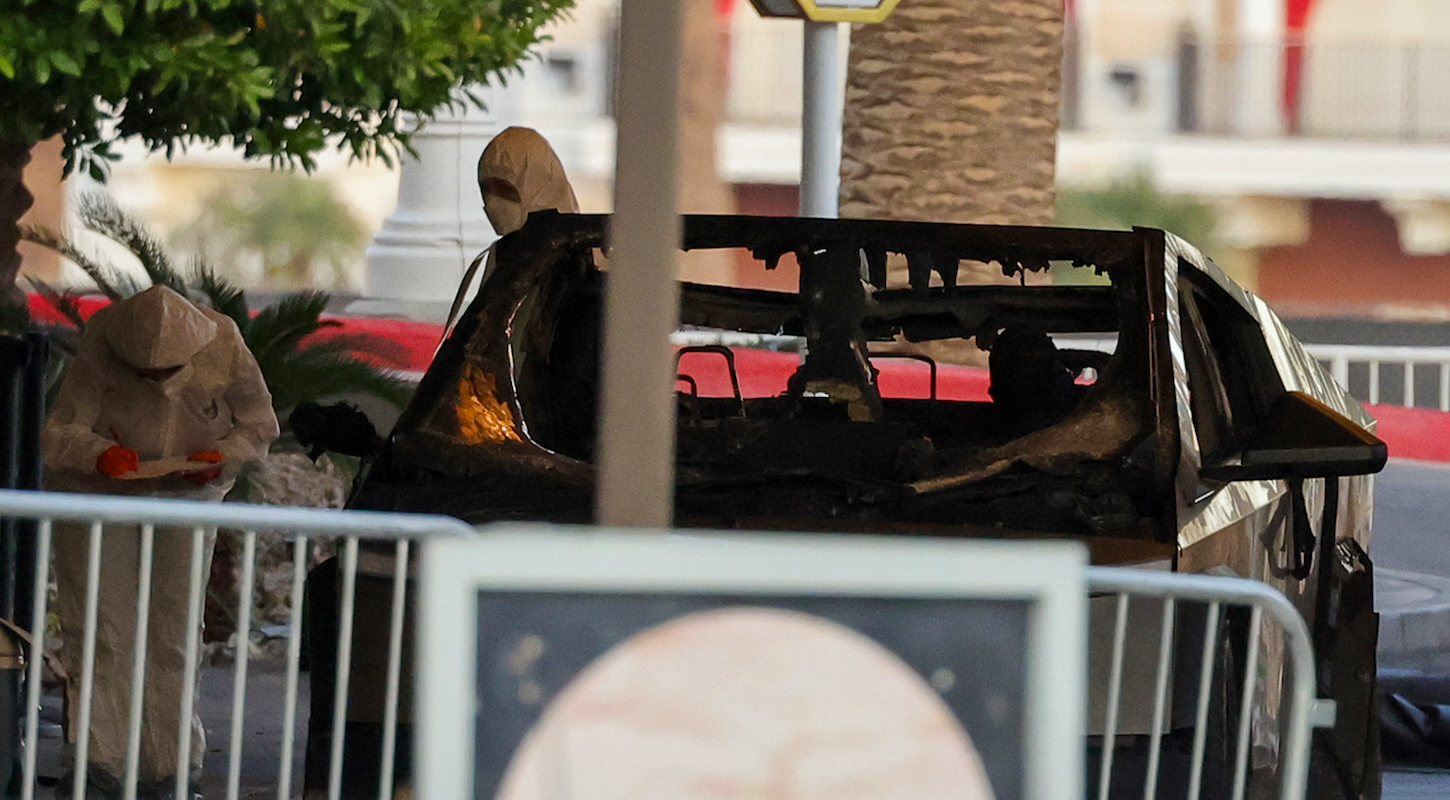Welcome to Margin of Error, a politics column from Tom Scocca, editor of the Indignity newsletter.
On Jan. 1, two separate American-born veterans of the occupation of Afghanistan died while using a rented truck to commit a sensational act of violence in a highly visible place in a major tourist destination. Shamsud-Din Jabbar reportedly pledged his allegiance to ISIS, then drove through a New Year's crowd on Bourbon Street in New Orleans, killing 14 and wounding dozens more before the police killed him in a shootout. The FBI said that he had declared he wanted to call attention to the "war between the believers and the disbelievers."
A few hours later, Matthew Livelsberger, an active-duty Green Beret, apparently shot himself in the head as he ignited a load of fireworks and other flammable material in a Tesla Cybertruck outside the doors of the Trump International Hotel in Las Vegas, leaving seven other people with minor injuries. Investigators released the text of messages from Livelsberger's phone in which he described his "stunt with fireworks and explosives" as "a wake up call" to the country. "Rally around the Trump, Musk, Kennedy, and ride this wave to the highest hegemony for all Americans!" he wrote.
In response to Jabbar's attack, the New York Times ran multiple stories about the dangerous international ideological influence of ISIS: "Amid New Orleans Attack, Telltale Signs of Islamic State's Brutal Legacy"; "How the Islamic State Radicalizes People Today"; "'I Joined ISIS': The New Orleans Attacker's Secret Radicalization." The pieces kept coming even after investigators declared that Jabbar had acted alone and that his pledge to ISIS appeared to be strictly one-way, with no known connection to any of the group's affiliates.
Just below that "Secret Radicalization" headline on its homepage, the Times had a story about what apparently brought Livelsberger to Las Vegas: "Soldier's Struggles Began Long Before Las Vegas Blast, Nurse Says." A separate article about his messages, published the day before, was headlined "Soldier in Tesla Blast Had PTSD and Feared U.S.'Collapse,' Officials Say"; a reader needed to get two-thirds of the way through it, past quotes from Livelsberger about how "our soldiers are done fighting wars without end states or clear objectives" and how he "needed to cleanse my mind of the brothers I've lost and relieve myself of the burden of the lives I took," to reach the part about how he wrote "that people should 'try peaceful means first but be prepared to fight' to get Democrats out of the federal government."
Jabbar and Livelsberger were both apparently showing signs of disturbance long before they rented their trucks, with the kind of unstable personal lives that almost always show up in the backstory of public acts of violence. Only one of them got his disturbance turned into a lesson on the menace of ideological radicalization.
Unavoidably, part of this was that Jabbar was Black and Livelsberger was white. Point by point, though, there were less pernicious reasons for the crimes to have landed differently in the media. A mass killing is a bigger deal than a suicide, even if the suicide involves arson and explosives. The Times in particular saw Livelsberger as one more case to jam into its ongoing grand investigative theory of the vast hidden toll of traumatic brain injury, which now sprawls from youth football players to Top Gun pilots.
But behind any available reasons and rationalizations was the well-established fact that the American press would rather attribute violence to the influence of ISIS than attribute violence to the influence of Donald Trump. ISIS is foreign and fits the consensus popular picture of "terrorism"; more pressingly, ISIS is not scheduled to be sworn in as president two weeks from now.
The striking feature of Livelsberger's writing was how ordinary it sounded. One of the two messages released by officials opened with a note-for-note cover of Trump's central campaign message: "We are the United States of America, the best country people to ever exist! But right now we are terminally ill and headed toward collapse." What followed was a litany of standard doomer and/or influencer populism, the sort of grievances that the Trump movement runs on and which Elon Musk retooled Twitter to concentrate and amplify.
"The top one percent decided long ago they weren't going to bring everyone else with them," Livelsberger wrote. "You are cattle to them." And: "A lot of us are just sitting around waiting to die. No sunlight, no steps, no fresh air, no hope. Our children are addicted to screens by the age of two. We are filling our bodies with processed foods." And: "Focus on strength and winning. Masculinity is good and men must be leaders. Strength is a deterrent and fear is the product." He complained about homelessness, called DEI a "cancer," and declared (while endorsing Donald Trump) "We are done with the blatant corruption."
His other message was just as familiar, in a slightly different key—the apocalyptic operator key of Steve Bannon and the most militant participants in the Jan. 6 attack on the Capitol:
Military and vets move on DC starting now. Militias facilitate and augment this activity.
Occupy every major road along fed buildings and the campus of fed buildings by the hundreds of thousands.
Lock the highways around down with semis right after everybody gets in. Hold until the purge is complete.
Try peaceful means first, but be prepared to fight to get the Dems out of the fed government and military by any means necessary. They all must go and a hard reset must occur for our country to avoid collapse.
Was this the tone of a mentally ill person? Yes. Was it the tone of the controlling faction of the Republican Party? Also, unquestionably, yes.
Throughout the Trump era, the media and non-Trumpist politicians have been fixated on the idea that there must be some bright line between political beliefs and mental illness, and that you can never blame one for the other. Someone who mails pipe bombs to prominent Democrats and the media, or who chases and tries to strangle a nonwhite person while shouting "This is Trump's America now!" is simply a disturbed individual, not a representative of the larger political situation. When deranged street people started punching Asian American passersby at the height of Trump's holding forth on the "Wuhan flu" and the "Chinnnnna virus," that couldn't have had anything to do with the president. Those people were plain crazy, and Trump was talking about the People's Republic of China, not anyone in America.
At its most absurd, the reflex to separate politics from insanity led Nancy Pelosi to her disastrous gambit, after the Capitol attack, of urging Trump's cabinet to declare him mentally unfit and remove him under the 25th amendment, rather than having the House impeach him on the spot. A president who tried to overthrow the constitution must have been too sick in the head to really be president. In the time Pelosi wasted, Trump threatened the Republicans back in line and escaped with his career intact.
Two years later, a Trump supporter broke into Pelosi's house, in the service of some deep MAGA conspiracy theory, and bashed her husband's head with a hammer. That person was certainly disconnected from objective reality, but that didn't make him any less of a Trump supporter. Trump himself thought the attack was funny enough to turn it into part of his crowd-pleasing rally routine:
"We'll stand up to crazy Nancy Pelosi, who ruined San Francisco—how's her husband doing, anybody know?" Trump said to a raucous crowd of California Republicans at a state party convention. "And she's against building a wall at our border, even though she has a wall around her house—which obviously didn’t do a very good job."
What does responsibility mean, under these circumstances? Or sanity? The president-elect deals entirely in fantasy, paranoia, and confusion. The willingness to believe his message, or at least to profess his message, is the organizing principle of the incoming government. He and his party leaders use the same talking points as mass shooters.
If Livelsberger did have PTSD, or even the traumatic brain injury the Times is hoping for, his violent and destructive impulses were still shaped by the political movement he supported. Nothing in his messages, as provided by law enforcement, was outside the boundaries of the MAGA coalition; he was no more incoherent than the person he praised as a "real President" is. His notion that detonating a truckload of fireworks and flammable material in front of an occupied hotel was "not a terrorist attack" was neatly congruent with Trump's address the morning of Jan. 6, telling his crowd that they had a constitutional duty to march on the Capital and "stop the steal," and to "fight like hell" as they did it, but that this mass interruption would be done "peacefully and patriotically."
The once and future Trump presidency is the result of a machine, built up over decades, to channel people toward fear and anger within a set of political stories. Some portion of the people who run the machine simply want that fear and anger to go toward people buying supplements and other scams, voting for representatives who'll cut top tax rates, posting sludge to keep the fear and anger circulating, and bullying officials in school board meetings. But more and more of them, apparently including the president-elect, believe more and more of it, or have forgotten how to distinguish it from any other, more verifiable versions of the world. None of them care if some of their audience gets even more inspired and does other things. Four years after his peaceful and patriotic supporters clubbed and gassed police to smash their way into the Capitol, Trump is reportedly on the verge of issuing mass pardons to the mob.
"Americans," Livelsberger wrote, "only pay attention to spectacles and violence."







